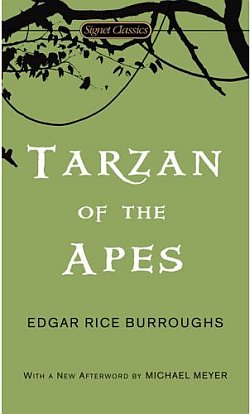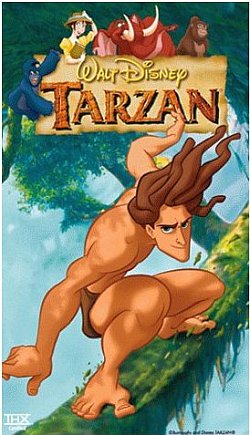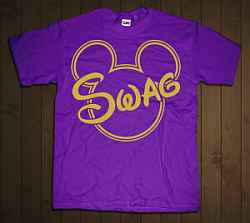
Tarzan of the Book

Tarzan of the DVD
Disney Swag: The T-Shirt

Get yours now!
Disney Swag: The T-Shirt

Get yours now!
Classic Disney Dispatch Content
 Review: A Walk in the Park with Rolly Crump
Review: A Walk in the Park with Rolly Crump
 Disney Dreadful: The Bus Beast
Disney Dreadful: The Bus Beast
Disney Dispatch Columns
 Because I Stinkin' Love Disney World
Because I Stinkin' Love Disney World
 Disney Travel Tips from Mouseketrips
Disney Travel Tips from Mouseketrips
More Disney Dispatch Features
 What the Church Can Learn from Disney
What the Church Can Learn from Disney
 DIZcovery: SamLand's Disney Adventures
DIZcovery: SamLand's Disney Adventures
Subscribe to Disney Dispatch Digest
And receive a daily email summary of new stuff on the site.
Before Disney: The Real Tarzan
Just when you thought it was safe to go back in the jungle
Film adaptations of popular books are rarely faithful. Liberties are taken. Liberties have to be taken, in most cases, because what reads well on the page doesn't always project well on the screen.
Disney films often feature familiar literary characters: Tarzan, Peter Pan, Alice, Hercules, and many more. When a familiar literary character becomes the subject of a Disney film, the character typically loses its rough edges, its bad habits, its juiciness, its zest. What remains is kid-friendly and park-ready. But wouldn't you like to sneak a peek behind the rubber smiles?
In this series, we'll look at characters before Disney got hold of them, taken straight from the pages of their original stories, myths, and novels, with all their juicy, zesty parts left intact. Prepare to be surprised, perhaps even shocked...
Edgar Rice Burroughs
Edgar Rice Burroughs, the creator of Tarzen, was a pulp writer, an enormously successful pulp writer, but still the type of author who realized that his livelihood depended upon simple themes and red-hot productivity.
His talents were well-suited to pulp fiction, then a grim affair replete with violent heroes, gory action, overtones of racism and sexism, and themes straight out of youthful fantasy: pirates, jungles, outer space, detectives, and whatever else happened to be in temporary vogue. Authors churned it out.
In 1912, Burroughs churned out Tarzan of the Apes, the first in a profitable series of novels and short stories about a savage but noble jungle lord. Burroughs initially relied upon a simple survival theme but soon incorporated all manner of science fiction, lost civilizations, and even a trip to Pellucidar at the earth's core.
Disney, of course, based its 1999 animated movie, Tarzan, on the original novel.
So how close was Burroughs' Tarzan to Disney's Tarzan? Hold onto your kepias and keep the porters in a straight line: the jungle gets wild ahead.
(If you plan to read the novel or watch the movie for the first time, be warned: this article contains spoilers.)
Murderous Mutineers
As the book opens, Tarzan's parents (John and Alice Clayton) are sailing to a British colony in Africa when the crew mutinies and murders the ship's officers, then dump the Claytons on a desolate stretch of African coast with minimal supplies.
In the movie, there are no mutineers, no murders, and no John and Alice Clayton: Tarzan's unnamed parents easily escape from a burning ship and row to shore where his father builds from scratch a spacious treehouse worthy of Architectural Digest.
Kerchak the Bi-Polar Ape
Caught by surprise in his simple cabin - not spacious treehouse! - while grieving the sudden death of his wife, John Clayton is torn to pieces by Kerchak, the leader of the local ape band. The female ape Kala then takes baby Tarzan from his crib and drops her own dead baby in its place (dead from a fall that happened during one of Kerchak's insane rages). She 'adopts' Tarzan and soon begins nursing him.
In the movie, Kala comes alone upon the bodies of Tarzan's anonymous parents, victims of a tiger attack, and takes their baby back to her tribe where we meet her mate and Tarzan's new father - Kerchak! No insane rages, no creepy crib-swapping.
Tarzan, Your Raw Meat Is Ready
Burroughs made Tarzan into an amazing, almost super-human predator. Armed with little more than a knife and a home-made noose, he kills gorillas, apes, even tigers. Later, when a tribe of cannibals establishes a village near the apes, Tarzan stalks their warriors and strangles from above them with his noose. In combat, he kills three alpha apes, including Kerchak. And he loves it! Tarzan is a natural killer who enjoys the hunt and especially enjoys placing his foot upon his vanquished victims and venting his mighty roar - then butchering the carcasses and eating the flesh raw. (Not human or ape flesh, though. Even Burroughs drew the line there.)
In the movie, Tarzan fights only when necessary, his body count limited to a leopard stabbed off-screen in self-defense. Needless to say, he doesn't rip hunks of meat from the carcass for a feast. And there are no cannibals, either. I don't think I've ever seen cannibals in an animated Disney movie. Tough fit.
Tarzan, You Have No Animal Friends
Tarzan got along with (and sometimes rode) elephants, but Burroughs graced him with no other animal friends, not even among his own kind: as the young apes of Tarzan's generation matured, they lost interest in playing with him and became sullen brutes who either feared Tarzan or plotted his demise.
In the movie, Tarzan has lots of cute, quirky animal friends, loyal companions good for laughs and occasional drama in the traditional Disney mold. But Tarzan isn't loyal to his friends in return, briefly abandoning them without farewell as he boards the ship bound for England. That's odd behavior for a Disney hero.
Moi Tarzan?
In some of the book's more morbid scenes, Tarzan spends considerable time in his parent's cabin squatting near their skeletons and doggedly teaching himself to read and write English from a dictionary and other books. But he can't speak English because he has no contact with other humans. When other people do arrive, they're French sailors and Tarzan learns to speak French from one of their officers, D'Arnot, whom he rescues from the cannibals. He continues speaking French throughout the novel - but never says 'Me Tarzan, you Jane' in French or in any other language.
In the movie, there are no French sailors. Jane teaches Tarzan how to speak English and in one of the film's sillier sequences he teaches her how to speak a few words in 'gorilla'. Unlike Burroughs' Tarzan, whose great intellect is apparent in his prodigious efforts to read and write English on his own, Disney's Tarzan is a bit of a dimwit who parrots words spoken to him.
Tarzan Gets Lucky with Jane
Tarzan is fascinated by Jane and from a distance falls in love with her immediately. When the ape Terkoz kidnaps Jane (Burroughs makes it clear that Terkoz wishes her for a mate), Tarzan pursues them through the jungle and kills the ape in mortal combat, a primal act which causes Jane to rush into his arms and kiss him passionately until she remembers that she's a demure English lady (Burroughs' Jane was American) and struggles to break free from his embrace. Tarzan doesn't let go right away.
In the movie, Tarzan is a gentleman whose 'passion' for Jane consists mostly of dreamy stares until Jane initiates a brief kiss at the very end. No steamy make-out scenes in the middle of the jungle.
Tarzan in ... Wisconsin!
In the book's odd, unexpected finale, Burroughs uproots Tarzan from the jungle and sends him to America in pursuit of Jane whose tangled love life involves two other suitors, including Tarzan's aristocratic cousin, William Clayton. Tarzan catches up with Jane on her Wisconsin farm (he drives there in a car!), rescues her from a forest fire, and then steps aside in favor of cousin William, clearing the way for Jane's rather loveless nuptials. Tarzan learns too late his true identity as heir to the Clayton fortune.
In the movie, William Clayton is the bad guy, not related at all to Tarzan, and more interested in capturing a gorilla than in wooing Jane. The action ends in Africa, where it began, with a show-down between Tarzan and Clayton, followed by Jane's impractical but essential decision to stay with Tarzan rather than return to England.
Real Tarzan Versus Disney Tarzan
Could Disney have filmed Tarzan of the Apes faithfully? Not a chance.
Burroughs wrote for a vastly different audience and the rougher culture of his era is apparent in the Tarzan novels and in all of his work. The Tarzan of literature is a savage impossible to domesticate. The Tarzan of film is never savage, never cruel, never anything but a kind, somewhat clueless guy attended by wild yet lovable beasts voiced by the likes of Wayne Knight (Newman!) and Rosie O'Donnell. A child who watches Tarzan and then later reads Tarzan of the Apes is in for a few rude awakenings.
Tarzan of the Apes is in the public domain. You can read it for free on-line at Project Gutenberg. But I suggest shelling out $4.95 for the Signet Classic edition. Not only is it more enjoyable to hold a book while you read it, but the Signet edition has a memorable introduction by Gore Vidal, one of the last people you'd expect as a Tarzan fan. Vidal read all of the Tarzan novels in his youth and seems still to have a soft spot for them even if his own work took him rather far from the jungle.
As for the film, it's textbook Disney: sweet, happy, slightly ominous, ultimately redemptive, though not by any means one of the studio's better productions. The book is none of those things. It power-washes modern kitsch bare with its relentless depiction of a dark, dangerous world where the bosom buddies of our childhood grow suddenly strange and indifferent and where we walk away from what we love.
Tarzan is a pluck at your heart; Tarzan of the Apes, a fist in your face.
 Don't stop there! More Features Await...
Don't stop there! More Features Await...
Stuff Not to Skip
- The official Tarzan Website
http://www.tarzan.org - Book review of Tarzan of the Apes
http://brothersjudd.com/index.cfm/fuseaction/reviews.detail/book_id/755 - Review of Disney's Tarzan
http://www.animationartist.com/movies/tarzan/Review/review.html - Project Gutenberg edition of Tarzan of the Apes
http://www.gutenberg.org/ebooks/78 - Signet Classics edition of Tarzan of the Apes
http://www.amazon.com/Tarzan-Signet-Classics-Edgar-Burroughs/dp/0451531027




